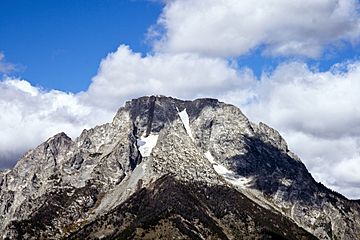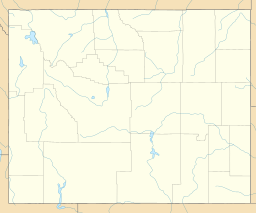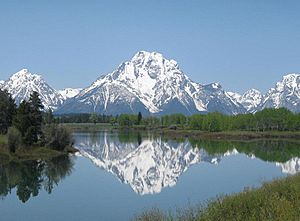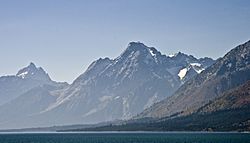Mount Moran facts for kids
Quick facts for kids Mount Moran |
|
|---|---|

Mount Moran summit with Falling Ice Glacier at left and Skillet Glacier at right
|
|
| Highest point | |
| Elevation | 12,610 ft (3,840 m) |
| Prominence | 2,605 ft (794 m) |
| Geography | |
| Parent range | Teton Range |
| Topo map | USGS Mount Moran |
| Climbing | |
| First ascent | LeGrand Hardy, Bennet McNulty, and Ben C. Rich, July 22, 1922 |
| Easiest route | CMC Face class 5.4 |
Mount Moran is a tall mountain in Grand Teton National Park in western Wyoming, USA. It stands at 12,610 feet (3,844 meters) high. The mountain is named after Thomas Moran, a famous American artist who painted landscapes of the American West. Mount Moran is a very noticeable peak in the northern part of the Teton Range. It rises about 6,000 feet (1,800 meters) above Jackson Lake.
Mount Moran has several active glaciers. The Skillet Glacier is easy to see on its huge east face. A unique feature of Mount Moran is a dark stripe on its face called the Black Dike. This stripe is made of a type of rock called basalt, which pushed its way into the mountain long ago.
Climbing Mount Moran
Mount Moran is a huge and impressive mountain that many climbers want to explore. However, getting to the climbing routes can be quite difficult. This makes it less popular for climbing compared to the Grand Teton and other peaks nearby.
There are no official trails to Mount Moran that have been kept up for over twenty years. If you try to walk there, you have to push through thick plants, fallen trees, and muddy areas around Leigh Lake. Because of this, most climbers choose to paddle a canoe from String Lake across Leigh Lake. Even after canoeing, they still need to find their way through the wilderness to reach their climbing path. This means that even shorter climbs on Mount Moran often take several days to complete.
The first time someone successfully climbed Mount Moran was on July 22, 1922. LeGrand Hardy, Bennet McNulty, and Ben C. Rich from the Chicago Mountaineering Club made this first ascent. They climbed using the Skillet Glacier route. This route is still one of the easiest ways to reach the top. It is rated as a 5.4 climb on the Yosemite Decimal System. Since most of this climb is on the steep snow and ice of the Skillet Glacier, climbers need special tools like an ice axe and crampons (spikes for boots).
The most popular way to climb Mount Moran is called the CMC route. It's named after the Chicago Mountaineering Club. The CMC route is rated as a 5.5 climb. It goes up the east face of the mountain, just south of the Black Dike. This route has good rock to climb on and usually doesn't have much snow or ice. It also has a good spot high up on the mountain where climbers can set up camp.
There is also a very challenging route called the Direct South Buttress. This is a technical climb that can be rated from 5.7 A3 to 5.9 C1. It's for experienced climbers who use special equipment to help them go up (this is called aid climbing). This route goes up about 1,500 feet (460 meters) and has 11 sections, or "pitches," to climb. This route is so famous that it's mentioned in a well-known climbing book called Fifty Classic Climbs of North America. Richard Emerson, Don Decker, and Leigh Ortenburger first climbed it on August 30–31, 1953.
History of Mount Moran
Mount Moran has also been the site of a sad event. On November 21, 1950, a C-47 cargo plane crashed on the mountain during a storm. All 21 people on board died. A rescue team, led by Paul Petzoldt, found the plane's wreckage on November 25. However, the crash site was in such a difficult and dangerous place that it was impossible to remove the plane or the bodies. The wreckage of the plane is still on the mountain today. The Park Service does not encourage people to climb to the crash site.
See also
 In Spanish: Monte Moran para niños
In Spanish: Monte Moran para niños




